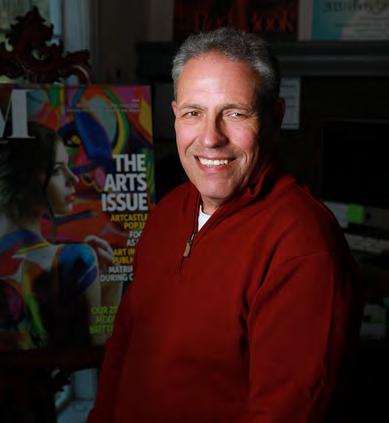
3 minute read
Letter from the Editor
from Ocala Magazine April 2021
by ocalamag
Not one deadly epidemic, but two
BY BRAD ROGERS
Advertisement
What a year. So much has happened. Lockdowns and crowd limits. Face masks and social distancing. Businesses failing with others flourishing. We Zoomed and Tik Tokked and worked from home. Hugs and handshakes were off limits. Yeah, what a year. Yet, life carried on. Babies were born. Couples were married. Taxes were collected. New buildings went up. And people died — so many people died. Somewhere amidst it all, we held a historic election. Our fair city moved forward, too. Ocala regained its place among America’s best places to live, according to people who measure such things. A 2020 U.S. News and World Report story, using U.S. Census Bureau statistics and other data, told us what we already knew: Ocala is a darn good place to live. And, according to that data, other people are finding out, too. In its rankings of the 150 largest cities across the land, U.S. News ranked Ocala as: • The 6th best place in the nation to retire because it is affordable and has great health care. • The 5th fastest growing place in the nation, behind, in order, Myrtle Beach, Fort Myers, Naples and Sarasota. Not bad company — and we did it without a beach. • The 10th best city to live in Florida, and 69th best place to live in the country. Yet, while we were busy learning to live in, indeed survive, a pandemic, another plague continued to grow “Fentanyl is a powerful and spread in our community. It, synthetic opioid that too, has reordered lives. It, too, has caused so many deaths.is similar to morphine The heroin/opioid crisis has but is 50 to 100 times worsened over the past year here more potent.” in Ocala. After beginning to see a decline in the number of cases, 2020 saw a surge again. The experts suspect it is fallout from the misery of the pandemic — lost jobs, lives and hope. This month Ocala Magazine looks at the opioid crisis in our community. How remarkably fast it gripped Ocala, how the community responded and how the crisis has evolved from being about prescription opioids and heroin to now focusing on fentanyl. What is fentanyl? According to the National Institute on Drug Abuse, “Fentanyl is a powerful synthetic opioid that is similar to morphine but is 50 to 100 times more potent.” And as Ocala Police Chief Mike Balken lamented, it’s cheap and easy to manufacture illegally. Oh, and it’s highly, highly addictive.
The heroin/opioid/fentanyl crisis has touched so many families in our community with the lives it has taken. But Ocala has responded vigorously.
When Mayor Kent Guinn saw the numbers of heroin/opioid deaths in 2017 — there were 79 — he called for the creation of a task force. The Marion County Children’s Alliance stepped up and created the Marion County Heroin/Opioid Task Force, bringing together law enforcement, drug rehab groups, and the health care community.
Ocala now has a coordinated effort that includes programs ranging from the Ocala Police Department’s Amnesty Program and the new Beacon Pointe “medication withdrawal” center to more drug rehab beds and widespread dispersal of Narcan, which can resuscitate someone who is overdosing on opioids.
Much credit goes to Nancy Castillo, the Children’s Alliance coordinator for the Community Council Against Substance Abuse and the point person for the task force. She has brought people together and, in the process, has made Ocala a model for other communities fighting the opioid scourge.
When Orlando officials, who early on advised Castillo and her cohorts on a heroin/opioid strategy, returned after the first year of the task force’s existence, they were impressed.
“They were amazed that what we had accomplished in one year had taken them three years,” Castillo told me. “And that’s because of the collaborators — you can’t do it without relationships.”
So, while the cloud of heroin/opioids still hangs over our community, there is a silver lining in what our community has done to respond to this killer. While cases are up, deaths are down. The reality, however, is more people will die.
“Every time I get a chance to get before a group, I point out that there is a good chance that someone in that group is addicted,” Castillo said.
Sadly, there is no vaccine to end this plague.










